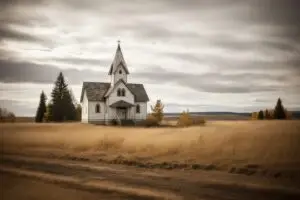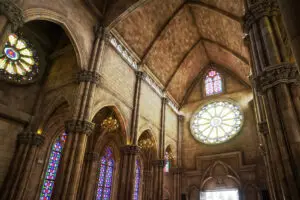Instructions had now been completed concerning the burnt offering, the grain offering, the sin offering, the guilt offering, the ordination offering, and the sacrifice of peace offering (7:37). Now each of these offerings was to be executed in the presence of the people for the setting aside of Aaron and his sons for the priesthood. To provide the intercession for others, they must be set aside and consecrated in every sphere in which they would stand as representative for the people. Nothing must be lacking in their own consecration in the way of being properly attired, dealing with thorough corruption, every sin, all guilt. They must be thankful and at perfect peace with God. Christ needed to make no sacrifices for himself in achieving this state of being a priest, well-pleasing to God in every aspect of his person, free of all pollution, guilt, transgression, and finding in his conscience and deportment nothing that would spoil his peace.
I. Consecrating the Priesthood – Leviticus 8:1-36
A. Verses 1-5: According to God’s command, Moses arranged everything and everyone for the ordination of the priests. Aaron and his sons were there, the garments that had been so carefully made for the priestly attire, the anointing oil, a bull, two rams, a basket of unleavened bread, and the congregation of Israel. They gathered at the doorway of the tent of meeting.
B. Verses 6-13: Moses washed and clothed Aaron and his sons. After washing, Aaron had every part of the high priests attire placed on him. Then he anointed the tabernacle and all of its furniture. The altar was anointed seven times along with all its utensils. On Aaron’s head, Moses poured some of the anointing oil. Then Moses clothed Aaron’s sons according to the commandment.
C. Verses 14-17: The bull was brought to make a sin offering for Aaron and his sons. They laid their hands on its head, Moses slaughtered it, sprinkled blood on the horns of the altar and disposed of all of it as required in the instructions for the bull of the sin offering.
D. Verses 18-21: The first ram for the Burnt Offering for Aaron and his sons was done “just as the Lord had commanded Moses.”
E. Verses 22-29: Aaron and his sons laid their hands on the second ram, the Ram of Ordination. Blood for the ram was placed on the lobe of the right ear, the thumb of the right hand, and the big toe of the right foot. The rest of the blood was sprinkled around the altar. All the parts of the ram, along with portions of the basket of bread were placed in the hands of the priests and the given back to Moses for his offering them on the altar with the exception of the breast, given as a wave offering and kept by Moses as his portion.
F. Verse 30: Though previously, Moses had anointed Aaron with the anointing oil, now he mixes it with the blood from the altar and consecrates Aaron and his sons with it.
G. Verses 31, 32: The part of the consecration ram that had not been offered and was not the portion of Moses was to be boiled and eaten along with the remaining bread by Aaron and his sons.
H. Verses 33-36: This process took place every day for seven days. See verses 5, 33, 34 and 36. The description in these verses was to take place every day for seven days. Thus, each day the food for them would be provided by the second ram, the ram of ordination. It was to be done as God had commanded Moses or else they would die. This should be remembered when we come to 10:1, 2. Times of sleep and times for the necessities of nature certainly would be accounted for each day.
II. The First Offices of the Priesthood – Leviticus 9. Now that these priests are set apart for the performance of their priestly duties, they do their first cycle of presenting offerings as God had commanded.
A. Getting everyone and everything together (1-7). All the provisions for the offerings to be given on this day were brought.
B. Verses 15-17: First was the sin offering and burnt offering for Aaron himself (8-14). All was done as required.
C. Next he was to perform the sin offering [goat], burnt offering [calf and lamb], and grain offering for the people (15-17). A portion of the sin offering, the goat, was to be reserved for Aaron and his sons to eat. On this occasion they did not consume this offering by eating it as we shall see soon.
D. Verses 18-21: Then the ox and the ram for the peace offering were slaughtered and all its parts were used and disposed of as required.
E. Verse 22-24: The Glory of the Lord appears to the People (22-24). When the sacrifices were complete, Aaron stepped down and he and Moses went into the “Tent of Meeting.” Then they came out and blessed the people having done as God commanded, and being fully propitiated ceremonially, the glory of the Lord appeared to the people. God himself appeared in fire and consumed from the altar what yet remained on it. God required the sacrifice, God designed the altar, and God consumed the sacrifice.
III. Offices interrupted by an unwarranted Intrusion into God’s Holiness 10:1-8
A. Nadab and Abihu offered strange fire cf. 6:12, 13; 16:12. God had given specific instructions about the use of fire; it was to be kept burning and any fire to be used in incense offering was to be taken from the altar. They also had been warned that any deviation from his commands would result in death (8:35).
B. The Lord kills them (2). We will come his way or we will not come at all; to come his way is life but to enter by another door is death. Jesus is the way, the truth, and the life; no man comes to the Father but through him. God executed these young priests with quick justice in the very genesis of the performance of the sacrificial system. In the early life of the church, God struck dead Ananias and Sapphira for lying about an offering.
C. Their action was considered a violation of God’s holiness and a failure to honor him. We do not know their motive. But God’s words spoken by Moses to Aaron indicated that they had not treated him as holy. Their attempt to offer incense on fire not prescribed by God amounted to idolatry committed in the most holy of events. They invented on the spot a manner of worship and a manner of sacrifice that God had not revealed. They assumed a greater knowledge of God and the way of reconciliation other than that required and revealed by God.
D. Relatives [cousins] removed the bodies. Aaron and their brothers must remain in their post.
E. Aaron and the two remaining sons, Eleazar and Ithamar, were not allowed to alter from their position as priests (6, 7). Their position at that moment was only official; they were serving as priests and were not allowed to consider personal feelings above the needs of the entire nation.
IV. Continuation of the First Office – 10:9-15
A. God speaks directly to Aaron warning him of the acute, unhindered discernment needed for the office. They must not partake of anything that would compromise their perceptions and their ability to perform every part of the sacrifices as revealed. It is significant that this admonition comes after the poor judgment and presumptuous actions of his sons resulted in their immediate destruction.
B. Aaron continues the grain offering (12, 13). Cf. 2:10 where “the remainder of the grain offering belongs to Aaron and his sons” and 6:16 – 18 “What is left of it Aaron and his sons are to eat.”
C. The breast of the wave offering, from the sin offering, remained to be eaten (14, 15) cf. 9:21 in fulfilment of 4:13-21; 6:26, 30 7:6, 7 and 31-34.
V. An exception made to the normal provision – 16-20: Aaron did not eat the wave offering of the sin offering.
A. Since the blood was not brought into the tent of meeting, it was to be eaten.
B. The substance of the sacrifices had been done with the sin offering and burnt offering. That which was to be food for him was consumed by fire rather than by Aaron and his two remaining sons. It was not allowed to corrupt. The uneaten portion was to be consumed by fire in any case, and so it was done on this occasion.
C. The provision of eating does not seem to be absolute, but one of reward, provision, and for joy.
D. Aaron had performed his task in spite of great sorrow. He had no desire to take advantage of the provision for he had no joy and the uneaten portion was burned with fire as required.
VI. Application
A. God’s people are represented in particular by the sacrifices that God provides. The sanctifying of the vestments represents the pure humanity of Christ as he stands as the representative of his people. According to Hebrews 2:10-17, Christ took our nature, true humanity, into himself that he might be a true representative of his people. Due to his infinite and eternal perfection combined with his temporally-wrought and human righteousness, he offered himself, shed his own blood, once-for-all gaining true and final remission of sins. Now there is no more offering for sin Hebrews 10:11-18).
B. The Sacrifice, the Priest, and the altar must all be purified properly. Christ purified the heavenly tabernacle with his own blood (Hebrews 9:21-28) and was himself consecrated to his priesthood by the shedding of the blood of the eternal covenant of redemption (Hebrews 10:29; 13:20, 21). If one rejects this blood and seeks another way of approaching God, he can look forward to nothing but divine judgment.
C. Every disobedience to God could bring forth immediate judgment; cf. Acts 5:1-11.
D. The Instructions were so precise because they would reflect the person, full obedience, and sacrificial death of Christ.
















